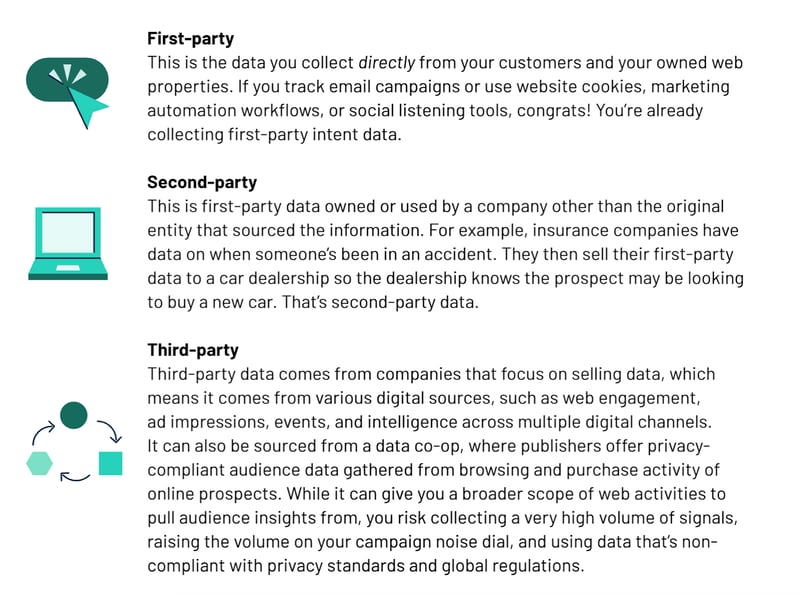For several years now, marketers and technology vendors alike have been preparing for the deprecation of third-party cookies.
In January, conversations around this topic got a bit louder as Google announced it was beginning to take action. When a company of Google’s size makes a change like this, it can be hard to navigate how this will impact all of the different tools and channels that are part of the typical B2B marketing mix — including G2. So we wanted to bring some clarity to how this will affect our G2 customers across our Marketing Solutions products.
Industry-wide, the deprecation of third-party cookies is a very big deal. There’s no doubt that it will impact how marketers collect and use data. But G2 customers should experience little change in how they interact with activity and intent data from the G2 marketplace.
In fact, in a time where third-party tracking is becoming more challenging, G2’s proprietary intent data — which is solely collected from our owned marketplace channels — is immune to disruption that other data providers may experience.
Taking a step back: the basics of third-party cookies
Before diving into what this all means for G2, let’s first take a moment to explain the context.
For the uninitiated: third-party cookies on your web browser are kind of like having someone put a tracking device on your car. They’ll be able to see where you are and what you are doing, and they may even be able to follow you there. And you might not even realize you’re being tracked!
When you see an ad on a website, there’s a strong chance that an algorithm processed a bunch of data about you that has been harvested over time to target you with a (hopefully!) highly relevant product.
This has been the status quo on the open web for some time now, and companies like Meta have built up billion dollar industries around this kind of ad tech. Today, due to legislative pressure and shifts in public sentiment around data privacy worldwide, this status quo is starting to shift.
By the end of 2024 it will be much, much harder for companies to track you across the internet. So how will this change impact customers of G2?
Thanks to our emphasis on first-party data, G2 Buyer Intent data is not impacted
At G2, we don’t use third-party cookies to track our Buyer Intent activity. Therefore, if you are using G2 Buyer Intent, which provides rich data on activities happening in our marketplace that correlate to purchasing intention, you won’t notice any change to your data.
Our product is unique in the intent space because we are the only provider that can offer insight into user behavior on G2. Because we own the marketplace where 90 million buyers come to discover, purchase, and manage their software every year, this is our first-party data (second-party to you, as a user of this data).
Naturally, we help software sellers connect with these buyers, but when buyers want to remain anonymous we don’t unmask them. Our Buyer Intent is structured around company-level intent; B2B software purchasing is often not a decision that can be made by one individual or in one day, so we help our sellers focus on the buyer teams, organizations, and companies that are most likely to be a lifelong customer match.
It's never been our intent to be purveyors of Personal Identifiable Information (PII), and so the shift away from third-party cookies will not impact G2 Buyer Intent users.

Understanding your profile traffic
Intent isn’t the only way we track buyer interaction on G2; we also provide data on buyers who visit both a vendor’s G2 profile and website to help that vendor understand the role G2 reviews play in the buyer journey. This can be done using our recently released UTM parameters, or using our Track Your Prospects functionality.
UTM parameters are an easy way to track referral traffic from G2, and fit with most people’s current marketing analytics workflows. Even better, there are no third-party cookie issues at play.
We are making a small shift to the technology used by Track Your Prospects, which monitors the two-way traffic between a vendor’s site and their G2 profile. As a user, it’s likely you wouldn’t even notice this shift if we weren’t sharing this deep dive.
While Track Your Prospects was built using a third-party cookie, we were never tracking visitors widely across the whole internet. We apply this tracking to a very tight use case: to determine if the same person (browser) visited two different websites – our customer’s website and their G2.com profile.
Leveraging a third-party cookie was an easy and straightforward way to capture that traffic, but luckily there are plenty of other ways we can do that. We’re transitioning to a lightweight, proprietary method of browser fingerprinting, which involves creating a mostly-unique profile of the browser visiting the website, drawing from data such as browser type and version, device info, and information from IP address lookup.
We can compare these browser profiles between G2.com traffic and customer web traffic to establish a reliable, bidirectional referral traffic metric. And even better, if you already have our Track Your Prospects script on your site, we can swap this out for the cookie without any action on your part.
The future of tracking in an age of data privacy and AI
As cookieless tracking evolves, there may be ripple effects from the loss of third-party cookies that no one anticipated, and in the age of AI we can be sure more changes are coming in martech.
Luckily, keeping up with the rapid pace of technology innovation is core to our mission as the definitive source of trust in B2B software.
Our Product and Research teams are committed to supporting software and services vendors as a reliable and trustworthy partner, connecting you to millions of buyers on our G2 marketplace.
 by Bikash Thokchom
by Bikash Thokchom
 by Sagar Joshi
by Sagar Joshi
 by Alyssa Quander Riley
by Alyssa Quander Riley